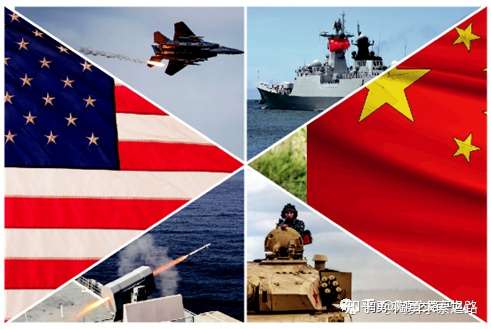南德直哭最新报告发表在2021年10月,最近国内开始披露,此报告共约7万字,我逐步翻译分批展示(其中页码可以忽略、注释附录略去),翻译主要为练手,此报告昆仑智库可能全部翻译在网上了。
昆仑智库翻译的报告名称是“大国战争的回归:美中之间可能的冲突情景”,但笔者认为“模式”也许比“情景”更贴切。以下是中英文对照内容,欢迎读者提出不同意见和批评!
The Return of Great Power War
Scenarios of Systemic Conflict Between the United States and China
大国战争的回归
美中之间可能的冲突模式

About This Report.. . . . . . . . . . . . . . . . . . . . . . . . . . . . . . . . . . . . . . . . . . . . . . . . . . . . . . . . . . . . . . . . . . . . . . . . . . . . . . . . . . . . . . . iii
关于本报告...
Figures and Tables.. . . . . . . . . . . . . . . . . . . . . . . . . . . . . . . . . . . . . . . . . . . . . . . . . . . . . . . . . . . . . . . . . . . . . . . . . . . . . . . . . . . . . . vii
图表
Summary.. . . . . . . . . . . . . . . . . . . . . . . . . . . . . . . . . . . . . . . . . . . . . . . . . . . . . . . . . . . . . . . . . . . . . . . . . . . . . . . . . . . . . . . . . . . . . . . . . . ix
摘要
Acknowledgments. . . . . . . . . . . . . . . . . . . . . . . . . . . . . . . . . . . . . . . . . . . . . . . . . . . . . . . . . . . . . . . . . . . . . . . . . . . . . . . . . . . . . . . . xv
鸣谢。...... ...... ...... ...... ...... ...... ...... ...... ......
Abbreviations. . . . . . . . . . . . . . . . . . . . . . . . . . . . . . . . . . . . . . . . . . . . . . . . . . . . . . . . . . . . . . . . . . . . . . . . . . . . . . . . . . . . . . . . . . . xvii
缩略语。...... ...... ...... ...... ...... ...... ...... ...... ......
Contents
内容
About This Report.. . . . . . . . . . . . . . . . . . . . . . . . . . . . . . . . . . . . . . . . . . . . . . . . . . . . . . . . . . . . . . . . . . . . . . . . . . . . . . . . . . . . . . . iii
关于本报告...
Figures and Tables.. . . . . . . . . . . . . . . . . . . . . . . . . . . . . . . . . . . . . . . . . . . . . . . . . . . . . . . . . . . . . . . . . . . . . . . . . . . . . . . . . . . . . . vii
图表
Summary.. . . . . . . . . . . . . . . . . . . . . . . . . . . . . . . . . . . . . . . . . . . . . . . . . . . . . . . . . . . . . . . . . . . . . . . . . . . . . . . . . . . . . . . . . . . . . . . . . . ix
摘要
Acknowledgments. . . . . . . . . . . . . . . . . . . . . . . . . . . . . . . . . . . . . . . . . . . . . . . . . . . . . . . . . . . . . . . . . . . . . . . . . . . . . . . . . . . . . . . . xv
鸣谢。...... ...... ...... ...... ...... ...... ...... ...... ......
Abbreviations. . . . . . . . . . . . . . . . . . . . . . . . . . . . . . . . . . . . . . . . . . . . . . . . . . . . . . . . . . . . . . . . . . . . . . . . . . . . . . . . . . . . . . . . . . . xvii
缩略语。...... ...... ...... ...... ...... ...... ...... ...... ......
CHAPTER ONE
第一章
Introduction.. . . . . . . . . . . . . . . . . . . . . . . . . . . . . . . . . . . . . . . . . . . . . . . . . . . . . . . . . . . . . . .
引言
Background: An Intensifying Great Power Competition
背景:日益加剧的大国竞争 .
Sources and Methodology.
来源和方法
CHAPTERTWO
Geopolitical and Military Trends
地缘政治与军事趋势
Geopolitical Trends.. .
地缘政治趋势
MilitaryTrends. . . . . . . . . . . . . . . .
. . . 军事趋势
Summary.. . . . . . . . . . . . . . . . . . . . . . . . . . . . . . . . . . . . . . . . . . . . . . . . . . . . . . . .
摘要. . . . . . . . . . . . . . . . . . . . . . . . .
CHAPTER THREE
第三章
. . . Insights from the Wars of Past Global Leaders. .
从过去全球霸权大国的战争中得到的启示
Which Are the Leading Great Powers?. .
Key Features of
哪些是霸权大国?.
Past Leading Great Powers..
曾经的霸权大国主要特点
Summary.
摘要
CHAPTER FOUR
第四章
Strategic Rivalry: Patterns in Crisis, Escalation, and Great Power Conflict.
战略竞争:危机、升级和大国冲突的模式
Characteristics of Rivalries.
敌对关系的特点
How U.S.-China Rivalry Might Escalate to Conflict.
为什么美中竞争可能升级为冲突
Rivalry with Chinese Characteristics..
有中国特色的竞争 . .
. . .
CHAPTER FIVE
第五章
How the People’s Liberation Army Might Prepare for a Systemic U.S.-China War.
人民解放军如何应对美中战争?
Context: The China Dream as the National Strategic Goal..
背景:作为国家战略目标的 "中国梦"......
Military Developments: Preparations for a U.S.-China Systemic War.
军事发展:为美中战争做准备
CHAPTER SIX
第六章
A Low-Intensity U.S.-China Conflict Scenario.
低强度的中美冲突模式
Geopolitical Assumptions..
地缘政治假设...... . . . . . . .. . . . . . . . . . . . . . . . . . . . . . . . . . . . . . . . .
China’s National Strategic Goals in a Low-Intensity Systemic War. .
中国在低强度战争模式中的国家战略目标
Chinese and Adversary National Interests
中国和竞争国家利益.
China’s Military Strategyina Low-Intensity Conflict Scenario.
中国在低强度战争模式中军事战略
CHAPTER SEVEN
第七章
A High-Intensity U.S.-China Systemic Conflict Scenario
高强度的美中冲突模式设想
Geopolitical Assumptions..
地缘政治假设......
China’s Wartime National Strategic Goals..
中国战时国家战略目标 .
China’s Wartime Military Strategy.
中国的战时军事战略 . .
.
CHAPTER EIGHT
第八章
Conclusion..
结语
Report Summary.
报告摘要
Implications for the Department of Defense.. .
对国防部的影响
References.. .
参考资料.....
Summary
This report explores scenarios of systemic U.S.-Chinese conflict in situations in which China has neared the point of global primacy. To help illuminate how war might unfold in such a circumstance, the authors examine trends in warfare and geopolitics, the behavior of select past great powers, and relevant patterns in interstate conflict. From these data, the authors formulate two scenarios of systemic war—one that is low-intensity and another that is high-intensity.
摘要
本报告探讨假设中国国力发展达到几乎全球首位的情况下,美中之间发生的冲突模式。为了说明美中“权力交接之战”将在这种情况下爆发,作者研究了战争和地缘政治趋势,既往大国行为模式,以及国家间冲突相关模式。根据这些数据,作者推断未来的美中冲突可能是低强度或高强度模式中 一种。
The intensification of strategic rivalry between the United States and China introduces political and security challenges that in key ways exceed what U.S. policymakers faced during the Cold War. Although the immediate risk of conflict remains low and U.S.-Chinese rela-tions are far less hostile than U.S.-Soviet relations tended to be, the two countries contend over a much broader range of issues than was the case during the Cold War. China and the United States routinely feud over an array of political, economic, technological, and ideo-logical issues. The two countries also maintain a tense standoff over dangerous flash points near China and argue over the role of human rights, democracy, and individual freedoms in international politics.1 Moreover, unlike the Cold War, which saw the United States enter the contest near the zenith of its economic might, in the current rivalry, the nation is in a period of relative decline. Even though its economic growth trajectory is slowing, Chinese national power continues to accrue at a rate faster than that of the United States. If the trends con-tinue, the Chinese economy could exceed the U.S. economy in nominal terms by the 2030s, although Chinese per capita gross domestic product (GDP) will continue to lag
美中之间战略竞争地加剧带来了政治和安全挑战,最关键的是这些挑战超过了美国政策制定者在冷战期间所经历的。虽然直接冲突的风险仍然很低,美中关系对峙程度也远低于美苏关系的敌对,但两国在更范围产生的分歧与争执远比冷战时期多得多。中国和美国经常在一系列政治、经济、技术和意识形态方面问题发生冲突。两国还在中国周边的热点区域一直紧张对峙,并就人权、民主和个人自由在国际政治中的作用激烈辩论。1 此外,不同的是,冷战时期美国是在经济实力接近顶峰的情况下投入竞争的,而在目前的竞争中,美国正处于相对衰退期。尽管中国经济增长的速度正在放缓,但中国国力增强的速度依然超过美国。如果这种趋势继续下去,到2030年代,中国经济按名义价值计算可能会超过美国,尽管中国的人均国内生产总值(GDP)将继续落后。
Should China successfully realize its ambitious Belt and Road Initiative (BRI), an ambi-tious Chinese-led effort to develop a massive trade and infrastructure network spanning much of Africa and Eurasia, the United States could one day find itself confronting a peer rival for global leadership possessing far greater power than the Soviet Union ever held. If, under such conditions, U.S.-China relations deteriorated into open hostility, the risk of mili-tarized crises and conflicts across many parts of the world could rapidly grow. The dangers of a global confrontation could be amplified by the advent of new, poorly understood civil-ian and military technologies and unprecedented historical developments. As one example, the ability of cybertechnologiesto inflict massive damage and dislocation raises problematic new escalation risks. Chinese success in extending a network of client states could also result in confrontations and crises involving U.S. interests that do not exist today. Many questions about such an important and dangerous situation arise. How might China’s national and security goals change if it were to engage in systemic conflict with the United States? How might the People’s Liberation Army (PLA) operate and modernize its forces in such a situa-tion? Where and how might conflict involving Chinese and U.S. forces unfold? What distinc-tive features of the Chinese military might enable or impede its ability to fight a systemic war with U.S. forces? While the answers to these questions remain ultimately unknowable, this report aims to encourage a preliminary consideration of them.
如果中国成功实现其雄心勃勃的 "一带一路 "倡议(BRI)——由中国主导、目标宏伟的横跨非洲和欧亚大陆的大规模贸易和基础设施网络,美国有一天会发现自己面对的是一个拥有比苏联还要强大的全球领导力的同行对手。如果在这种情况下,美中关系恶化为公开的敌对,世界上许多地方发生军事危机和冲突的风险会迅速增加。全球对抗的危险可能因新的、不为人知的民用和军用技术的出现以及前所未有的历史发展而被放大。例如,网络技术造成大规模破坏和混乱的能力产生了新的风险升级问题。中国在扩大客户国网络方面的成功也可能导致涉及美国利益的对抗和危机,尽管这些对抗和危机今天并不存在,但许多严重而危险的问题将会产生。如果中国与美国发生冲突,中国的国家和安全目标将会有什么变化?在这种情况下,中国人民解放军将如何运作并使其军队现代化?中美两军的冲突可能在哪里爆发以及如何开打?中国军队的哪些特点可能使其有能力或阻碍其与美军进行系统性战争?虽然这些问题的答案最终仍是未知的,但本报告旨在鼓励对这些问题进行初步探究。
We aim to analyze potential U.S.-China systemic conflict under conditions in which China has neared the point of global primacy through a careful synthesis of current and his-torical data on relevant factors, anticipated trends, and research-grounded speculation. For this report we considered academic and research findings regarding the potential trajectory of international security and warfare in coming years, China’s approach to future warfare, relevant experiences from preceding great powers, and historic patterns of interstate conflict.
我们的目的是通过仔细综合有关因素的当前和理论数据、预期趋势和有研究基础的猜测,分析在中国已接近全球首要地位的条件下潜在的美中系统性冲突。在这份报告中,我们考虑了有关未来几年国际安全和战争的潜在轨迹、中国对未来战争的态度、以前大国的相关经验以及国家间冲突的历史模式的学术和研究结果。
Drawing from these findings, we then developed two scenarios of U.S.-China systemic conflict. The first scenario consists of pervasive low-intensity, or indirect, conflict. The pri-mary means of fighting consists of combat by the militaries of partner countries or favored nonstate groups, as well as paramilitary and defense contractors. These proxy U.S.-China conflicts could be waged as part of intrastate or interstate conflicts. The fighting would take place against the backdrop of considerable international fragmentation and the proliferation of nonstate threats, which would add its own stresses on the two militaries. Extensive conflict that involved partners of both countries could raise demand for military assistance to cope with their own threats as well. The militaries of the two contending great powers could find themselves under immense pressure to respond to the competing demands while sustaining their low-intensity war efforts against one another.
根据这些发现,我们预测了两种美中系统性冲突情景。第一种情况是低强度的间接冲突——主要发生在美国伙伴国家的军队或受支持的非政府组织以及准军事部队和国防承包商。这些美中代理战争冲突可能是国内或国家间冲突的一部分,它将发生在国际社会严重分裂和非国家威胁扩散的背景下,这将给两国军队带来压力。涉及两国伙伴的广泛冲突可能产生军事援助的需求,以满足各自应对战么偶中事的需要。两个相互竞争的大国军队(指美中:译者注)可能会发现自己处于巨大的压力之下,要对各自伙伴的战事需求进行支持,与此同时,还要竭力避免美中发生低强度以上战争。
The low-intensity conflict scenario envisions these clashes as occurring primarily along the BRI routes that China has prioritized as the geographic basis of its international power. While avoiding direct conventional war with one another, relevant Chinese and U.S.- backed military units could support partners in combat operations against the rival power and its own partners. The two militaries could also engage each regularly in cyberspace and in the information domains. Conventional military forces would continue their buildup and preparations for major combat operations but operate primarily as deterrent forces or par-ticipate in limited operations such as those against nonstate actors or other forces backed by the rival power but in which the risk of escalation to high-intensity great power war remained low. War waged primarily through indirect means would leave open the possibil-ity of U.S.-Chinese cooperation on some shared concerns, in a manner somewhat evocative of how relations between the Soviet Union and the United States stabilized despite their waging indirect conflict against one another through proxies around the world. If the com-batants successfully avoided escalation and maintained the conflict at a low enough level, they might be able to sustain some trade and investment with each other. The result could be a chronic state of conflict featuring minor positional changes in influence in different parts of the world but also considerable stability. The stalemate could last years. Yet, despite the apparent stability, the risk of escalation would remain substantial because either side could tire of the persistent conflict and risk major high-intensity operations to bring the war to a conclusion.
低强度冲突的设想是,这些冲突主要发生在中国优先谋划的作为国际力量地理基础的BRI(一带一路:译者注)路线上。在避免彼此直接发生常规战争的同时,中国和美国各自支持自己合作伙伴军事组织针对对敌对势力及其阵营作战。两国军队还在网络空间和信息领域频繁地交锋。常规军事力量继续为主要作战行动提供支持和准备,但主要作为威慑力量或参与有限的行动,如针对非政府军事组织或其敌对大国支持的力量,但升级为高强度的大国战争风险仍然很低。主要通过间接手段发动的战争将为中美两国在某些共同关注的问题上进行合作留下相应空间,这种方式有点像当年苏联和美国之间“摩而不裂的关系,尽管它们通过世界各地的代理人发动了间接冲突。如果交战双方成功地避免冲突升级,并将冲突维持在足够低的水平,他们也许能够维持彼此间的一些贸易和投资。其结果可能是一种长期的冲突状态,其特点是在世界不同地区的影响力有轻微的位置变化,但也有相当的稳定性。这种僵局可能持续多年。然而,尽管表面上稳定,升级的风险仍然很大,因为任何一方都可能对持续的冲突感到厌倦,并冒着大规模高强度行动的风险来结束战争。
The second scenario consists of a high-intensity war and expands on many features of the low-intensity conflict. Indeed, it envisions considerable continuity with the low-intensity systemic war scenario. The two sides would continue to maintain low-intensity war efforts as low-cost means of distracting and bleeding away vital military and other resources for the rival power. As in the previous scenario, a gridlocked and fractured international order could yield an expansion of nonstate threats, potentially endangering the interests of both China and the United States.
第二种冲突模式包括一场高强度的战争,并扩展了低强度冲突的许多特征。事实上,它设想了与低强度系统性战争情景相当大的延续性。双方将继续保持低强度战争的努力,作为转移和吸走对手大国重要军事和其他资源的低成本手段。如同前一种情况,一个僵持和分裂的国际秩序可能会产生非国家威胁的扩大,可能会危及中国和美国的利益。
Amid this situation of low intensity war and international fragmentation, the militaries in this high-intensity scenario initiate direct hostilities. Although traditional flash points such as Taiwan provide the most plausible proximate cause, others are possible. New flash points could emerge over time as well. The advent of high-intensity combat operations would intro-duce a new phase in conflict, and the two sides could rush to exploit the possibilities after a perhaps years-long period of chronic, indecisive low-intensity conflict. Although either side might begin the high-intensity war with restrained goals in mind, the urge to escalate into a broader war of decision regarding the issue of systemic leadership could be difficult to resist. For example, China’s ambition to shatter U.S. power could motivate it to rapidly escalate an initial clash arising from a crisis in Asia by striking U.S. military assets and facilities throughout the theater. The war in the first and second island chains could thus be characterized by extensive air, maritime, and missile attacks.6 China’s willingness to engage in high-intensity operations in other parts of the world might similarly seek as a goal the deg-radation of U.S. combat power and ability to sustain major war. The possibility of kinetic and nonkinetic strikes on the homelands of both countries cannot be excluded either.
在这种低强度战争和国际分裂的情况下,这种高强度的情景中的军队会发起直接敌对行动。虽然像台湾这样的传统爆发点提供了最合理的近因,但其它也可能如此。随着时间的推移,新的爆发点也可能出现。高强度作战行动的出现将引入冲突的新阶段,双方在经历了可能长达数年的长期、优柔寡断的低强度冲突之后,可能会急于利用这种可能性。尽管任何一方在开始高强度的战争时都可能抱着克制的目标,但要升级为一场关于系统性领导权问题的更广泛的决定性战争的冲动可能难以抵挡。例如,中国粉碎美国力量的野心可能促使它迅速升级由亚洲危机引起的最初冲突,对整个战区的美国军事资产和设施进行打击。因此,第一岛链和第二岛链的战争可能以广泛的空中、海上和导弹攻击为特征。中国在世界其他地区参与高强度行动的意愿可能同样以削弱美国的战斗力和维持重大战争的能力为目标。也不能排除对两国的本土进行动能和非动能打击的可能性。
A high-intensity war to decide the issue of systemic leadership would thus likely feature extensive combat around the world and across all domains. It would likely involve many combatants as partners of one side or the other. The war could include a variety of over-lapping war aims for China beyond the severe weakening of U.S. power. China could carry out amphibious or other ground operations in nearby countries to protect clients, punish adversary governments, and secure territory. In countries close to China’s borders, such as in Central Asia, South Asia, and Southeast Asia, the PLA could carry out direct interven-tions to bolster the efforts of rebel groups and governments engaged with U.S.-backed forces. If U.S. military forces operated in those regions, there could be risks of direct engagements, especially in regions along China’s land borders, such as Southeast Asia.
因此,一场决定系统性领导权问题的高强度战争可能会在世界各地和所有领域爆发,可能导致一方或另一方盟友的相关战斗人员卷入。这场战争除了严重削弱美国的实力之外,还可能包括中国的各种重叠的战争目的。中国可以在附近国家开展两栖或其他地面行动,以保护客户,惩罚对手政府,并确保领土安全。在靠近中国边境的国家,如中亚、南亚和东南亚,中国人民解放军可以进行直接干预,以支持反叛团体和政府与美国支持的武装力量进行抗衡。如果美国军队在这些地区活动,可能会有直接交战的风险,特别是在沿中国陆地边界的地区,如东南亚。。
Outside these areas, China’s eagerness to secure an Indian Ocean route could lead it to deploy major joint combat formations to seize vital choke points in the Middle East, perhaps in conjunction with a coalition of client military forces that might include paramilitary and contractor armed groups. With a de facto alliance with Russia, China could also rely more on overland routes to transport larger combat forces, opening opportunities to deploy larger combat formations farther afield. PLA forces could also step up combat support to client states in Central Asia and the Middle East to threaten any groups aligned with the United States.
在这些地区之外,中国急于确保印度洋航线的安全,可能会导致它部署主要的联合战斗编队,以夺取中东地区的重要咽喉要道,也许会与可能包括准军事和承包商武装团体在内的客户军事力量联盟合作。由于与俄罗斯建立了事实上的联盟,中国也可以更多地依靠陆路运输大型作战部队,为在更远的地方部署大型作战编队提供机会。中国人民解放军部队还可以加强对中亚和中东地区客户国家的战斗支持,以威胁任何与美国结盟的团体。
Direct combat operations between Chinese and U.S. forces beyond the Middle East would be more difficult for the PLA to carry out, owing to the limitations of its power projection capabilities. However, in our scenarios we do not rule out the possibility of some sort of clash involving both militaries in those areas. Chinese military assets based on the Mediterranean coast in North Africa or on the coasts of East Africa or West Africa could engage passing U.S. naval and air assets as well, as might Chinese naval ships that escort merchant ships through the Arctic. In a climate of major war featuring contested environments, the PLA would struggle to safely transport large volumes of military equipment to more distant loca-tions. PLA bases, assets, and personnel in Africa, Latin America, and the Middle East could come under attack by U.S.-backed forces. To support its clients in these areas, China could seek to provide weapons such as air defense missiles, unmanned combat systems, and other portable weapons and equipment. Small numbers of PLA troops could also travel to help advise and direct the efforts of client militaries. But client states and nonstate groups would, in this scenario, bear the brunt of the fighting in the most distant regions.
由于力量投射能力的限制,中国和美国军队在中东以外地区的直接作战行动对解放军来说将更难进行。然而,在我们的设想中,我们并不排除两国军队在这些地区发生某种冲突的可能性。驻扎在北非地中海沿岸或东非或西非海岸的中国军事力量也可能与路过的美国海军和空军力量交战,在北极地区护送商船的中国海军舰艇也可能如此。在一个以争夺环境为特征的重大战争环境中,解放军将很难把大量的军事装备安全地运送到更远的地方。解放军在非洲、拉丁美洲和中东的基地、资产和人员可能受到美国支持的部队的攻击。为了支持其在这些地区的客户,中国可能会寻求提供诸如防空导弹、无人驾驶作战系统和其他便携式武器和设备等武器。少量的解放军部队也可以前往帮助客户军队提供建议和指导工作。但在这种情况下,客户国和非国家团体将在最遥远的地区承担战斗的主要任务。
This report concludes with some observations and hypotheses about how the PLA might perform in the posited combat scenarios. It also reviews key challenges and vulnerabilities
本报告最后对解放军在上述战斗场景中的表现提出了一些看法和假设。报告还回顾了关键的挑战和弱点。
Summary
摘要
that could affect the PLA’s battlefield performance. The implications and recommendations herein would apply chiefly to a hypothetical conflict situation in which China had neared global primacy. However, the conclusions could inform defense planning for potential con-tingencies even today. Our first finding is that planners may need to consider a broader range of contingencies for low- or high-intensity war when contemplating possible combat involv-ing China. Most defense planning scenarios focus on flash points such as Taiwan within an assumed context of U.S. primacy. These scenarios tend to envision a relatively contained set of combat operations that concludes with the resolution of China’s attempt to subjugate the island. This approach might make sense in a situation in which China experienced signifi-cant inferiority compared with the United States, such as Iraq did when the United States defeated its efforts to annex Kuwait in the first Gulf War. But China could consider combat options in a dramatically different way in conditions in which it had grown powerful enough to more aggressively contend for global primacy. In such circumstances, the drive to escalate an initial clash to a broader war of power transition could be difficult to resist, regardless of the outcome of the initial battle near a flash point such as Taiwan.
在此,我们将对可能影响解放军战场表现的因素进行分析。本文的意义和建议主要在于假设与接近全球首要地位的中国发生冲突的情形。因此,这种假设甚至可以为今后潜在冲突的防御计划提供参考。我们的第一个发现是,防御计划制定者在考虑可能涉及中国的冲突时,可能需要考虑更广泛的低强度或高强度战争之意外情形。大多数国防规划方案都集中在诸如台湾这样的热点地区,并假定美国占主导地位。这些方案倾向于设想一套相对封闭的作战行动,以瓦解中国征服该岛的企图。在中国与美国相比处于明显劣势的情况下,这种方法可能是有意义的,比如在第一次海湾战争中,美国击败了伊拉克吞并科威特的努力,伊拉克就是这样。但是,在中国已经强大到可以更积极地争夺全球首要地位的情况下,中国可以以一种截然不同的方式考虑作战选择。在这种情况下,将最初的冲突升级为更广泛的权力过渡战争的动力可能难以抵挡,无论在台湾这样的热点地区周围最初战斗结果如何。
Second, planners may need to consider U.S.-China conflict less as a single battle or war than as a series of sequentially related, geographically dispersed clashes between U.S.- and Chinese-aligned forces. A systemic war could last years, involve many participants, and span virtually all domains, even if it stayed at the level of low-intensity conflict. The possibility that U.S. military forces might be severely stressed by competing demands for security assistance by allies and partners or to tackle severe transnational threats should be considered as well. Third, the United States should consider bolstering its ability to wage indirect war, given our conclusion that a scenario of indirect, low-intensity conflict is more plausible than that of high-intensity war. Fourth, the analysis of high-intensity war has underscored the impor-tance of ensuring the U.S. ability to defend and secure vital choke points in the Middle East and along the Indian Ocean. Fifth, U.S.-China conventional conflict scenarios outside the first island chain could consist mainly of engagements between intelligence, surveillance, and reconnaissance sensors and modest-size units of long-range strike systems, as well as poten-tial clashes involving irregular and proxy forces. Planners who seek to anticipate such sce-narios may want to focus on weapons and platforms that help gain the information advantage and mitigate long-range strike capabilities. Alliance building to develop counterinsurgency capabilities could be useful as well.
其次,规划者可能需要将美中冲突视为美国和中国结盟部队之间一系列顺序相关、地理上分散的冲突,而不是单一的战斗或战争。一场系统性的战争可能会持续数年,涉及许多参与者,并且几乎跨越所有领域,即使它停留在低强度冲突的水平上。美国军事力量可能会因为盟友和合作伙伴对安全援助的竞争性要求或应对严重的跨国威胁而受到严重压力,这一点也应予以考虑。第三,鉴于我们的结论是,间接的、低强度的冲突比高强度的战争显然更为“划算”,因此,美国应该考虑增强其发动间接战争的能力。第四,对高强度战争的分析强调了确保美国在中东和印度洋沿岸的重要咽喉部位的防御和安全能力的重要性。第五,第一岛链以外的中美常规冲突模式可能主要包括情报、监视和侦察传感器与中等规模的远程打击系统之间的交战,以及涉及非正规部队和代理部队的潜在冲突。作为预判未来形势的规划者也许应该把防范重点放在有助于获得信息优势和减轻远程打击能力的武器和平台上。当然,建立联盟以发展反叛乱能力也是值得考虑的选择。
Acknowledgments
鸣谢
The authors thank the reviewers of this report, Michael J. Mazarr, Phillip C. Saunders, and Mike Bond. They also thank the sponsors of the study.
作者感谢本报告的审稿人Michael J. Mazarr, Phillip C. Saunders和Mike Bond。与此同时,还感谢本研究的赞助商。
xv
Abbreviations
缩略语
A2/AD anti-access/area denial
A2/AD 反介入/区域拒止
AI artificial intelligence
AI 人工智能
BRI Belt and Road Initiative
BRI 一带一路倡议
C4ISR command, control, communications, computers, intelligence, surveillance,
and reconnaissance
C4ISR 指挥、控制、通信、计算机、情报、监视和侦察。
CCG Chinese Coast Guard
CCG 中国海岸警卫队
CCP Chinese Communist Party
CCP 中国共产党
DoD Department of Defense
DoD 美国国防部
GDP gross domestic product
国内生产总值
ISR intelligence, surveillance, and reconnaissance
ISR 情报、监视和侦察
NATO North Atlantic Treaty Organization
NATO 北大西洋公约组织
PAP People’s Armed Police
PAP 中国人民武装警察部队
PGM precision-guided munition
PGM 精确制导弹药
PLA People’s Liberation Army
PLA 中国人民解放军
SCO Shanghai Cooperation Organization
上海合作组织
SLOC sea lines of communication
SLOC 海上交通线

 红歌会网 SZHGH.COM
红歌会网 SZHGH.COM


